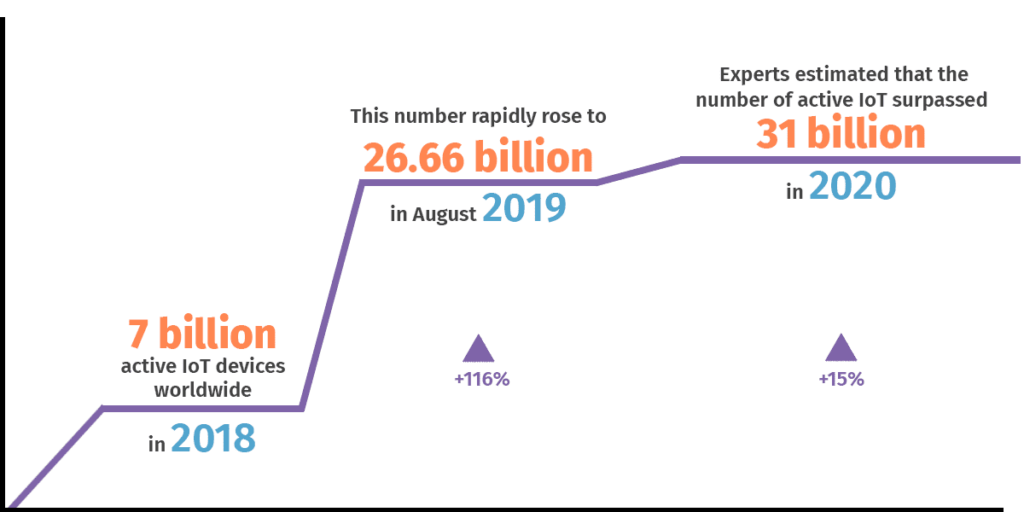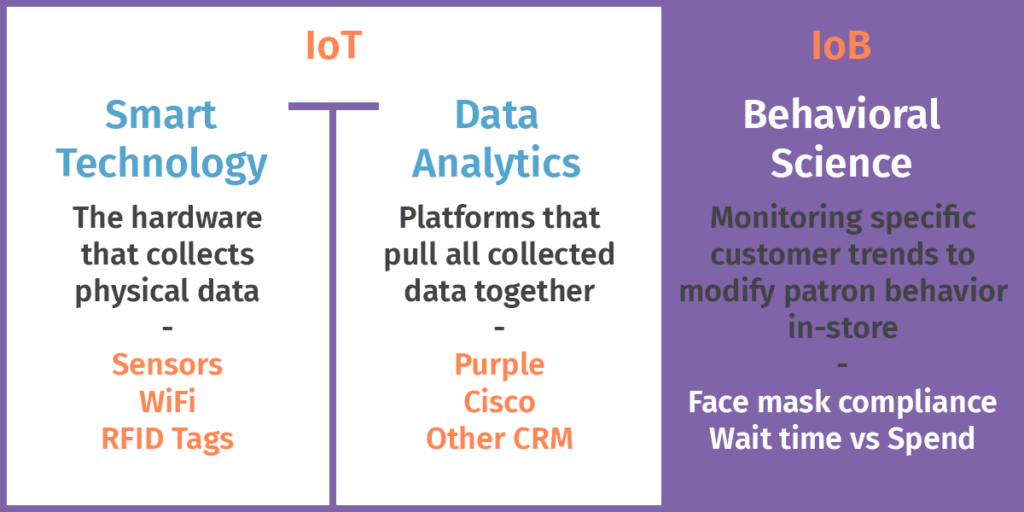A quick summary of IoT – The “Internet Of Things”
The “Internet of Things” was coined by British technology pioneer, Kevin Ashton in 1999, defining it as a system in which the internet is connected to the physical world by utilizing sensors and RFID tags.
You can visualize the ‘IoT’ as being made up of two parts. First is the physical tech and second, data analytics. As you may already know, businesses around the globe have already taken advantage of this ability to capture data to improve internal operations, customer experience, and staff safety.

What is the Internet of Behavior?
Put simply, the ‘IoB’ is all about using data that’s been collected by the ‘IoT’ to modify behaviors and ultimately end in an objective being met. For example: If you’ve ever had, or known someone that has had a black box in their car; the insurance provider can collect data on acceleration, braking, and other factors affected by the driver. In turn, insurance companies can use this data to prompt changes and make drivers safer on the road.
Another example:
Live Music/Stadiums – If you’ve ever been to a concert, you’ll know that during the intermission the drinks bars and toilets become very crowded. By using smart cameras, the venue owners are able to track occupancy and foot-flow. With this data the venue can display approximate waiting times, benefiting both the customer experience and drinks sales.
What separates the Internet of Behavior from ‘IoT’?
Despite this section being about differences, the Internet of Behavior, just like the ‘IoT’ is made up of Smart Tech and Data Analytics, these two pillars are the foundation for businesses to start understanding customer behavior.

Behavioral Science is what makes the ‘IoB’ to the next level. By tracking purchases, facial recognition and a whole lot more, businesses can begin to map and predict behaviors. With this information, businesses can make decisions to influence their customers based on solid data.
One example of this could be in your local coffee shop! If all customers are having to wait in the same queue meaning only one person is being served at a time, the IoB would be able to show the number of customers who stay and wait to be served vs customers who churn after x amount of time.
With this information, the venue owners could change the shop floor plan and create additional queueing space. By having this solution in place, not only are customers now happier for being served quickly but the customers that previously churned are now willing to wait.
Marketing Opportunities
It’s clear to see that as marketing methods and abilities have changed over the decades, businesses and marketers have had to adapt and master these techniques, at risk of being left behind.
Today, in order to take advantage of the data mounds collected by the ‘IoT’ businesses will need to start looking to those with a background in behavioral science. This new role/team will be focused on the understanding and change of the data collected.
Here are some examples of what this role/team would focus on:
Operational Efficiency – The ‘IoB’ can be used to scrutinize and change internal operations such as how often staff wash their hands & frequently used equipment. If this were to be coupled with the above queue management example then the coffee shop will be optimized to run cleanly (protecting visitors & the business) while serving double the customers.
Recorded Sales vs Forecast – As it’s not uncommon for businesses to already use sales forecasts, you can be fairly certain that this is an area that will only become more accurate. Those hired to make sense of the collected data will be able to confidently say when the peaks and troughs of daily sales are. This then allows the decision-makers to predict the best times for promotional items, seasonal deals, and other factors that can affect the customer buying decision.
Other factors:
Trends – The ever-changing world we live in has become unpredictable for everyone, but especially for those who once led the way in trends and movements, such as fashion designers and celebrities. While these types still hold a lot of influence within the general populous, trends and movements appear to be led and owned by groups.
This factor will be very important for those working with behavioral science because if it’s possible to catch on to a relatable trend quickly then attracting a new audience is a big possibility.
Ethical and Privacy Risks
Whenever the collection, use, and distribution of large amounts of data occurs there will always be concerns and questions raised. Despite this type of data handling becoming ever more popular, and the new ‘IoT’ integrating with all aspects of life, it’s clear that in the western world we are quick to accept tech that makes our lives easier, regardless of the personal information we have to surrender.
Additionally, as the pool of information businesses have access to increases, it also becomes increasingly difficult to track, monitor and regulate.
This begins to raise ethical issues…
With a lack of monitoring and regulation (even on an international scale), data security becomes an issue. Not only is the possibility of data theft by email phishing going to rise over the coming years but businesses that handle big data become instant targets for cybercriminals.
Another ethical issue could rise with companies gathering data without having to ask for individuals’ permission. Referring back to a car insurance scenario, we all accept that the information we’re asked to provide before taking out a policy is fairly standard, but what if insurance companies could view the way we interact on social media as a contributing factor for the risk of an accident.
So what next?
In a word… growth.
It’s estimated that by 2025, the number of globally active IoT devices will reach 75 billion if not more. By looking at the rate of adoption for the ‘IoT’, we can confidently predict that the rate won’t slow anytime soon, and only increase as technology develops and becomes cheaper.
50% of smartphone users will be using cryptocurrency instead of online banking to make more secure purchases. According to a Gartner press release, this ability will provide trading opportunities for emerging markets across the globe.
The increased rate of smart technology implementation will massively impact the amount of data being captured. This means that businesses will have to find new software solutions to deal with the collection and understanding of tracked behaviors.
Both national and international governments will need to work together to ensure that data handling, use, and distribution by corporations (public) / administrative sectors (private) are done so by following a strict set of rules, regulations, and principles.
Not only will this protect the entities legally but also to ensure that the personal information they have collected is kept incredibly secure because as we know, the more data, the higher it’s value.
